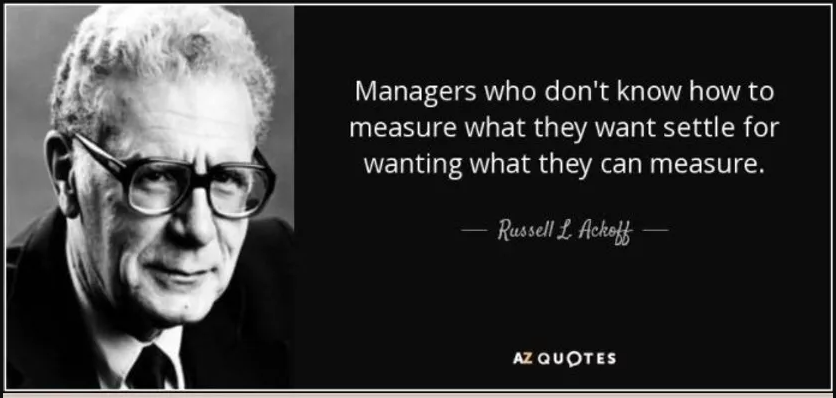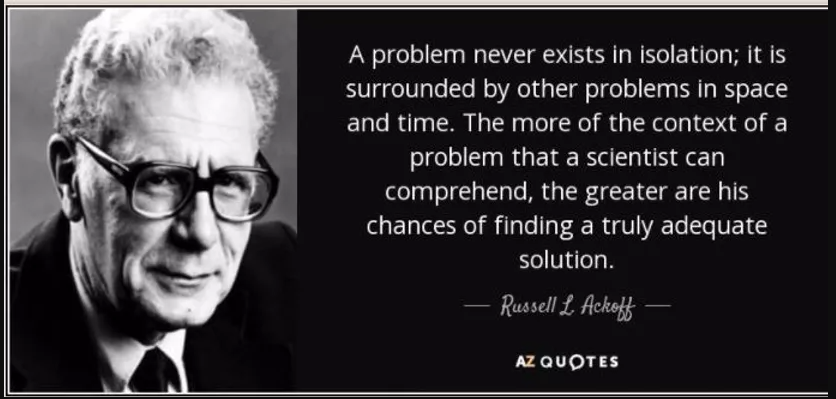I work with service and knowledge work organisations and it's often quite surprising to them how much they can improve performance by just stopping making things worse.
Of course, its not that people are knowingly making things worse, in most cases, they are actively trying to make things better and unknowingly making things worse.
Organisations, and in particular Service and Knowledge Work Organisations, are what's known as Complex Adaptive Systems or CAS for short. They are complex because of all the "moving parts" and they are adaptive because they are constantly adapting to the environment in which they operate.
Most importantly, they are Systems, not clockwork mechanisms where a finely engineered set of "movements" interact with each other in a mechanistic fashion. A system is "whole" whose parts or sub-systems interact to form that whole. There is no "equilibrium" or perfect state, they can't be finely tuned by an omnipotent management team to "eliminate variation".
In a system, the interaction of the parts is more important than the performance of any one part and by making any one part "better" in isolation, we often make the system worse. What's more, to improve the performance of a system, we often need to make 2,3,4 or more simultaneous changes as no individual change is, of itself, sufficient to change the systems performance.
The following is an example:
Union and Management Negotiate "Help" for Contact Center Teams Coping with Stress.
I was asked to help a contact center team improve their effective capacity because the team of agents were stressed-out by calls from customers who were annoyed by the poor response times and overall service levels.
Having gathered the underlying data, it emerged that the "call abandon rates" were running at around 15% and their target "response time" of 85% answered within 60 seconds was almost never achieved.
The unions were pushing for more staff which the management were prepared to provide. However the staff attrition levels were so high at 30% and the training period was so long (3 months to fully skilled because of the complexity of the various systems), by the time new people had been fully trained, they were just about filling the vacancies and not growing additional capacity.
The first step in addressing any system and its associated "systemic problems", is to be clear as to what it is you want the system to do and then compare the results the system is delivering.
The following is a key truism:
The performance of any system is entirely congruent with the actions, values and beliefs of its combined stakeholders!
The problem is that peoples espoused or articulated values and their aspirations are often in conflict with what they do in practice. It's also often the case that some stakeholders actions, values and beliefs have more impact on the system than others.
To paraphrase Russell Ackoff again, no experienced "systems thinker" could look at the "University Education System" and conclude that its primary function is to educate students. Its primary function, as evidenced by its "systemic behavior", is to facilitate lecturers doing research and teaching is the "pain they suffer" or "price they have to pay" to achieve their goals!
Coming back to the example, as this is intended to be a short article, I wont detail the elaborate conversations we had and the variety of views expressed. Sufficient to say that it took many conversations before we agreed on two desired outcomes of "the system":
Answer calls before the customer hangs up:
Measure = Zero Dropped Calls !
Solve the callers problem during the duration of the call:
Measure = Zero follow-up calls on same incident
It was agreed that achieving both of these goals would solve the underlying or root cause of the problem: callers are annoyed and angry at the service they are receiving!
Result:
Within 3 months the team had moved to 99% zero dropped calls, overall call volumes dropped by 30% (people are not calling 2,3 or more times) and by the following year the team had won "best customer service team in their industry".
Staff morale also dramatically improved and the attrition levels dropped to below 10%, very low for the sector. It proved difficult to measure the second performance measure as the IT systems in use required a significant upgrade to achieve it
This gives rise to another of Russ's expert observations:

There were many things the team did to achieve the results that they did. However, one in particular that shocked all the stakeholders is worth mentioning.
The data showed that an "average call handling time" of 140 seconds. In the course of gathering the data we discovered that the union had negotiated a "70 second "pause time" between calls to allow agents recover from the aggressive calls and the phone system had been programmed so that all agents had a 70 second break between every call.
What's more, the team and the union were actively negotiating to increase the "pause time" and I was asked to recommend a new "pause time". Having thought about it overnight, I came back the next day and asked for all the parties to attend a meeting on the subject. To everybody's surprise and some peoples anger, I made 2 suggestions, the first being that we get rid of the pause completely.
By adding the 70 second pause, the team had effectively reduced their capacity by 30%. Any effective solution to the problem would have to result in increasing the effective capacity and/or reducing the call volumes.
Given that all parties agreed that recruiting additional resources couldn't work in the circumstances as outlined above, increasing the pause time would only reduce the already poor service level and make the situation worse and not better.
Once the initial anger and irritation calmed down I was asked how would we address the issue of staff who were genuinely feeling very stressed, even if my proposal worked in the medium or long term. My 2nd recommendation puzzled people even more than my first.
I recommended that, in return for eliminating the built-in pause, people would be allowed to "log out" of the phone system and take their own pause if they felt stressed.
Somewhat bemused, the union representative asked me how long would I recommend that people be allowed "log out" for? I said "I suggest we tell them to take as long as they need to recover" A stony silence fell on the room as people absorbed the implications of the proposal , each from their own perspective.
The union representative was puzzled as to where the catch was and the management were puzzled as to how they would "monitor it".
My suggestion was that we all a meeting of all the staff and explain the situation as follows:
Our analysis of the underlying problem
Why we think the current efforts were making things worse
What the range of actions being suggested are and why we think they will work
Our proposal on eliminating the "pause" and why it would make things better and not worse although it would take some weeks to take effect.
Every reduction in effective capacity would only make things worse, so closing all capacity leakages was key to solving the problem and this was one of the major ones.
Other capacity gaps were closed by agreement such as the gap between shift and break handovers. We asked the teams to agree that no agent could leave for a scheduled break unless their replacements had taken over the phone.
A promise that, if anybody felt really stressed out in the interim, they could "log out" from calls and take their own "pause time"
There would be no monitoring of individual peoples "pauses", we were going to "trust them to understand the impact of any lost capacity and to work together to solve the problem". People might be interested to know that "pause time" almost never happened and when it did, nobody ever mentioned it.
We agreed on the two measures of success above that we would all work to.
As indicated above, the overall result was remarkable but ultimately it came down to undoing a number of interventions that "good people" thought were "good ideas", its just that they made things worse.
In trying to influence the performance of a complex adaptive system (CAS), leaders need to think more like chess masters, a few moves ahead. They shouldn't think like crossword puzzle wizards, trying to find the "one right answer".
Like in chess, there is no "one right answer" to a game and unfortunately, many of the "right moves" are also counter intuitive. This is because, of themselves they may not have a direct impact on the desired outcome, but rely on a number of other moves that in combination deliver the winning result.
Which reminds me.......why do we often judge the quality of our decisions against our intuition or "gut feel". If you're interested, try reading Daniel Kahneman's great book "Thinking, Fast and Slow"
